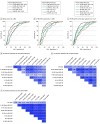Head-to-Head Comparison of 8 Plasma Amyloid-β 42/40 Assays in Alzheimer Disease
- PMID: 34542571
- PMCID: PMC8453354
- DOI: 10.1001/jamaneurol.2021.3180
Head-to-Head Comparison of 8 Plasma Amyloid-β 42/40 Assays in Alzheimer Disease
Erratum in
-
Error in Figure.JAMA Neurol. 2023 Apr 1;80(4):422. doi: 10.1001/jamaneurol.2022.5184. JAMA Neurol. 2023. PMID: 36648932 Free PMC article. No abstract available.
Abstract
Importance: Blood-based tests for brain amyloid-β (Aβ) pathology are needed for widespread implementation of Alzheimer disease (AD) biomarkers in clinical care and to facilitate patient screening and monitoring of treatment responses in clinical trials.
Objective: To compare the performance of plasma Aβ42/40 measured using 8 different Aβ assays when detecting abnormal brain Aβ status in patients with early AD.
Design, setting, and participants: This study included 182 cognitively unimpaired participants and 104 patients with mild cognitive impairment from the BioFINDER cohort who were enrolled at 3 different hospitals in Sweden and underwent Aβ positron emission tomography (PET) imaging and cerebrospinal fluid (CSF) and plasma collection from 2010 to 2014. Plasma Aβ42/40 was measured using an immunoprecipitation-coupled mass spectrometry developed at Washington University (IP-MS-WashU), antibody-free liquid chromatography MS developed by Araclon (LC-MS-Arc), and immunoassays from Roche Diagnostics (IA-Elc); Euroimmun (IA-EI); and Amsterdam University Medical Center, ADx Neurosciences, and Quanterix (IA-N4PE). Plasma Aβ42/40 was also measured using an IP-MS-based method from Shimadzu in 200 participants (IP-MS-Shim) and an IP-MS-based method from the University of Gothenburg (IP-MS-UGOT) and another immunoassay from Quanterix (IA-Quan) among 227 participants. For validation, 122 participants (51 cognitively normal, 51 with mild cognitive impairment, and 20 with AD dementia) were included from the Alzheimer Disease Neuroimaging Initiative who underwent Aβ-PET and plasma Aβ assessments using IP-MS-WashU, IP-MS-Shim, IP-MS-UGOT, IA-Elc, IA-N4PE, and IA-Quan assays.
Main outcomes and measures: Discriminative accuracy of plasma Aβ42/40 quantified using 8 different assays for abnormal CSF Aβ42/40 and Aβ-PET status.
Results: A total of 408 participants were included in this study. In the BioFINDER cohort, the mean (SD) age was 71.6 (5.6) years and 49.3% of the cohort were women. When identifying participants with abnormal CSF Aβ42/40 in the whole cohort, plasma IP-MS-WashU Aβ42/40 showed significantly higher accuracy (area under the receiver operating characteristic curve [AUC], 0.86; 95% CI, 0.81-0.90) than LC-MS-Arc Aβ42/40, IA-Elc Aβ42/40, IA-EI Aβ42/40, and IA-N4PE Aβ42/40 (AUC range, 0.69-0.78; P < .05). Plasma IP-MS-WashU Aβ42/40 performed significantly better than IP-MS-UGOT Aβ42/40 and IA-Quan Aβ42/40 (AUC, 0.84 vs 0.68 and 0.64, respectively; P < .001), while there was no difference in the AUCs between IP-MS-WashU Aβ42/40 and IP-MS-Shim Aβ42/40 (0.87 vs 0.83; P = .16) in the 2 subcohorts where these biomarkers were available. The results were similar when using Aβ-PET as outcome. Plasma IPMS-WashU Aβ42/40 and IPMS-Shim Aβ42/40 showed highest coefficients for correlations with CSF Aβ42/40 (r range, 0.56-0.65). The BioFINDER results were replicated in the Alzheimer Disease Neuroimaging Initiative cohort (mean [SD] age, 72.4 [5.4] years; 43.4% women), where the IP-MS-WashU assay performed significantly better than the IP-MS-UGOT, IA-Elc, IA-N4PE, and IA-Quan assays but not the IP-MS-Shim assay.
Conclusions and relevance: The results from 2 independent cohorts indicate that certain MS-based methods performed better than most of the immunoassays for plasma Aβ42/40 when detecting brain Aβ pathology.
Conflict of interest statement
Figures


